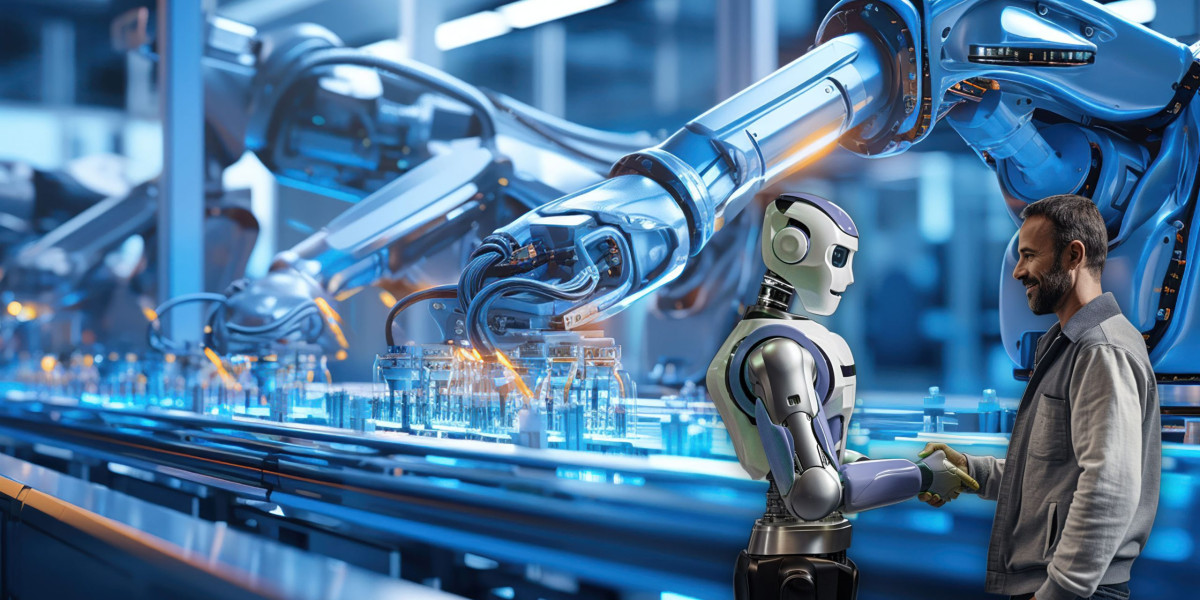Manufacturing, the bedrock of our global economy, has always been an industry of innovation. From the first industrial revolution driven by steam power to mass production and automation, it has continuously adapted. Today, we stand at the precipice of another monumental shift, powered by Artificial Intelligence (AI) Manufacturing And AI. Far from just automating tasks, AI is injecting intelligence, foresight, and adaptability into every facet of the manufacturing process, transforming factories into smart, self-optimizing ecosystems.
Let's explore the profound impact of AI on manufacturing, its key applications, and the exciting future it promises.
Why AI for Manufacturing? The Urgency of Intelligence
Traditional manufacturing, while efficient, often operates with a degree of reactivity. Breakdowns occur, quality issues arise, demand fluctuates unexpectedly, and supply chains face unforeseen disruptions. In a fiercely competitive global market, manufacturers need to move from reactive to proactive and predictive, from static to dynamic and adaptive. This is where AI steps in.
AI enables manufacturers to:
Extract Actionable Insights from Data: Factories generate enormous amounts of data from sensors, machines, quality checks, and supply chain logistics. AI algorithms can process this "big data" at speeds and scales impossible for humans, uncovering hidden patterns, predicting future events, and providing real-time, actionable insights.
Automate Beyond Repetition: While traditional automation (like robotics) handles repetitive physical tasks, AI introduces cognitive automation – enabling machines to "think," learn, and adapt.
Optimize Complex Systems: Modern manufacturing involves intricate processes, interdependencies, and vast networks. AI can optimize these complex systems for efficiency, cost, and quality across the entire value chain.
Key Applications of AI in Manufacturing: Where Intelligence Meets Production
AI's influence spans the entire manufacturing lifecycle, from design to delivery. Here are some of the most impactful applications:
Predictive Maintenance:
The Problem: Unexpected equipment breakdowns are a nightmare, leading to costly downtime, production delays, and missed deadlines.
AI's Solution: AI models analyze real-time data from sensors (vibration, temperature, pressure, acoustics) on machinery. By identifying subtle patterns and anomalies that precede failure, AI can predict when a machine is likely to break down. This allows maintenance teams to schedule interventions proactively, during planned downtimes, rather than reactively after a catastrophic failure. This can reduce maintenance costs by up to 25% and dramatically cut unscheduled downtime.
Quality Control and Defect Detection:
The Problem: Manual visual inspection is tedious, prone to human error, and slow, especially for high-volume production.
AI's Solution: Computer Vision (a branch of AI) powered by deep learning models can be trained on vast datasets of product images (both flawless and defective). High-speed cameras capture images of products on the assembly line, and AI instantaneously inspects them for defects (scratches, misalignments, impurities, assembly errors) with superhuman speed and accuracy. This ensures consistent product quality, reduces waste and rework, and identifies root causes of defects faster. AI-based visual inspection can increase defect detection rates by 90% or more.
Generative Design and Product Development:
The Problem: Traditional product design is iterative and time-consuming, often limited by human intuition and conventional approaches.
AI's Solution: Generative AI and machine learning algorithms can explore thousands or even millions of design permutations based on specified parameters (material properties, weight, strength, cost, manufacturing constraints). This enables engineers to rapidly discover innovative and optimized designs that might never have been conceived otherwise, significantly accelerating the product development cycle and leading to superior products.
Supply Chain Optimization and Demand Forecasting:
The Problem: Global supply chains are incredibly complex, vulnerable to disruptions, and difficult to manage with fluctuating demand.
AI's Solution: AI analyzes historical sales data, market trends, economic indicators, social media sentiment, and even weather patterns to provide highly accurate demand forecasts. This helps manufacturers optimize inventory levels, prevent overstocking or stockouts, and fine-tune production schedules. AI also enhances supply chain resilience by predicting potential disruptions (e.g., supplier issues, logistics bottlenecks) and suggesting alternative routes or suppliers, leading to significant reductions in logistics costs and improvements in inventory levels.
Intelligent Automation and Robotics (Cobots):
The Problem: Traditional industrial robots are rigid and perform fixed, repetitive tasks, lacking adaptability.
AI's Solution: AI-powered robots and collaborative robots (cobots) can learn from their environment, adapt to changing conditions, and work safely alongside human employees. AI enhances robot vision, grip, and decision-making capabilities, allowing them to handle more complex tasks, adapt to product variations, and even learn new skills without extensive reprogramming. This leads to more flexible and efficient assembly lines.
Process Optimization:
The Problem: Identifying bottlenecks and inefficiencies in complex manufacturing processes can be challenging and often relies on trial and error.
AI's Solution: AI analyzes real-time production data from across the factory floor to identify inefficiencies, optimize machine settings, balance workloads, and suggest improvements to production parameters. This continuous optimization leads to higher throughput, reduced energy consumption, and less waste.
Worker Augmentation and Safety:
The Problem: Manual, repetitive tasks can lead to fatigue, errors, and safety risks for human workers.
AI's Solution: While automating mundane tasks, AI also augments human capabilities. AI-powered exoskeletons can reduce physical strain. AI-driven work instructions adapt to worker skill levels, and AI-powered vision systems can monitor work environments for safety hazards, preventing accidents. This allows human workers to focus on higher-value, more cognitive tasks.
Challenges in Adopting AI in Manufacturing
Despite the immense potential, implementing AI in manufacturing isn't without its hurdles:
Data Availability and Quality: AI thrives on data. Manufacturers often face challenges with fragmented, inconsistent, or insufficient data from legacy systems.
Integration with Legacy Systems: Integrating new AI solutions with existing, often older, factory equipment and IT infrastructure can be complex and costly.
Lack of Skilled Workforce: A significant talent gap exists in manufacturing for professionals with both operational knowledge and AI/data science expertise.
Initial Investment and ROI Justification: The upfront investment in AI technologies, software, and training can be substantial, requiring clear ROI projections.
Change Management and Employee Resistance: Introducing AI changes job roles and workflows, necessitating careful change management strategies to ensure employee buy-in.
Cybersecurity Concerns: An interconnected factory with AI systems presents new cybersecurity vulnerabilities that must be rigorously addressed.
The Future of Manufacturing: The Rise of the Intelligent, Autonomous Factory
The trajectory of AI in manufacturing points towards increasingly intelligent, adaptive, and eventually, autonomous factories. We can expect:
Hyper-Personalization and Mass Customization: AI will enable manufacturers to produce highly customized products at scale, responding to individual customer preferences efficiently.
Digital Twins for End-to-End Optimization: Virtual replicas of physical assets, processes, and even entire factories will be powered by AI to simulate, predict, and optimize operations in real-time.
Edge AI and Decentralized Intelligence: More AI processing will happen closer to the data source (on the factory floor) for faster decision-making and reduced reliance on centralized cloud infrastructure.
Human-AI Collaboration at Scale: The focus will shift from replacing humans to augmenting their capabilities, creating a highly skilled and efficient workforce where humans and intelligent machines collaborate seamlessly.
Sustainable Manufacturing: AI will play a critical role in optimizing resource consumption, reducing waste, and improving energy efficiency, contributing to more environmentally friendly production.
Conclusion
Artificial intelligence is not just a technological upgrade for manufacturing; it's a fundamental paradigm shift. By infusing intelligence into every step of the production process, AI is enabling manufacturers to overcome long-standing challenges, unlock unprecedented efficiencies, enhance quality, and foster greater agility and resilience. While the journey of AI adoption in manufacturing presents its own set of challenges, the path towards the intelligent factory is clear, promising a future of smarter, more sustainable, and highly competitive industrial production.







